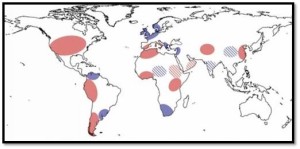By Gavin Roy

An example map of anomalies in global precipitation during the MCA. Red ovals indicate drier conditions; blue ovals indicate wetter conditions; and hatched ovals indicate greater uncertainty in the paleorecords. Image reproduced from Diaz et al.
Since the Industrial Revolution in the 18th and 19th centuries, carbon dioxide in the atmosphere from the burning of fossil fuels has increased from 280ppm (parts per million) to 390ppm across the globe. This has led to a net warming in the atmosphere to a magnitude that is still being quantified. Complicating the quantification, however is the difficulty of separating natural cycles in the Earth’s orbit (Milankovitch cycles) from human-induced changes in greenhouse gas emissions.
The last time the Earth was entering into a similar warm period due to natural changes in the Earth’s orbit was during medieval times, around 950 AD. This warmer period, dubbed the Medieval Climate Anomaly, or MCA, persisted until approximately 1400 AD. The Earth then slowly started shifting into what is now called the Little Ice Age, which lasted from 1400 to 1900 AD. These eras are confirmed by paleoclimatic records, including ice cores, tree rings and sedimentary analysis. Actual data from weather instruments also substantiate the last few centuries of the Little Ice Age.
Since the beginning of the 20th century, a steady warming has been well-documented by human observational data and ongoing paleoclimatic research. This warming has also been successfully reproduced in retrospective climate models given the known increase in carbon dioxide concentration in the atmosphere.
Thus, as we prepare for the effects of a slightly warmer climate, we look to the past to see how the Earth adapted to the most recent similarly-warmer period, the MCA. Paleorecords from high- and mid-latitudes in the Northern Hemisphere indicate that temperatures were, for several decades, just as warm as during the 20th century. Ice data show that sea ice recession in many areas was just as intense as it has been recently. However, some geological records show no noticeable signals of a warm phase.
It can, therefore, be hypothesized that the MCA was stronger in some areas than in others; modifying each region’s climate in different ways. One would expect today’s global warming to behave in a similarly non-uniform manner. This non-uniformity includes differences in magnitude of change and differences in geographic location. This latter difference is one that is often forgotten when discussing changes in the Earth’s climate.
Recent global climate change is not to be a question of ‘if’ but rather of ‘how much.’ Ongoing comparative studies between the MCA and today’s climate will further contribute to a definitive answer to our climate change questions that will not end with determining simply ‘how much’ but will go on to include ‘where.’
Reference:
Diaz, Henry, Ricardo Trigo, Malcolm Hughes, Michael Mann, Elena Xoplaki, and David Barriopedro. “Spatial and Temporal Characteristics of Climate in Medieval Times Revisited.” Bulletin of the American Meteorological Society. Nov. 2011: 1487-1500. Print.

Comments are closed.